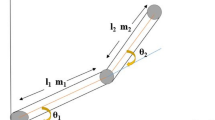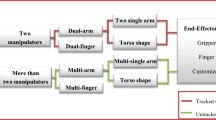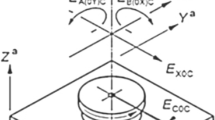Abstract
This paper introduces a novel planar parallel manipulator used as the tool holder in a 4-axis CNC machine. The manipulator has two translational and one rotational degree-of-freedom (DOF) while one of the translational DOFs is decoupled from the other two DOFs. The inverse and direct position kinematics of the manipulator are solved in closed form. Velocity, acceleration and singularity analyses are implemented using Jacobian matrices and it is shown that the proposed manipulator can be easily designed to have a singularity-free workspace. An analytical method is presented to determine workspace of the manipulator. A closed form solution is also presented for the inverse and direct dynamics of the manipulator by Newton–Euler method. Moreover, a kinematic conditioning index and a dynamic conditioning index are evaluated on the workspace revealing that the manipulator has a good dexterity especially in the center of the workspace.











Similar content being viewed by others
References
Merlet J-P (2012) Parallel robots. Springer, Berlin
Huang Z, Li Q, Ding H (2013) Theory of parallel mechanisms. Springer, Berlin
Chen S-L, You I-T (2000) Kinematic and singularity analyses of a six DOF 6-3-3 parallel link machine tool. Int J Adv Manuf Technol 16(11):835–842
Chen S-L, Liu Y-C (2001) Post-processor development for a six degrees-of-freedom parallel-link machine tool. Int J Adv Manuf Technol 18(4):254–265
Harib K, Srinivasan K (2003) Kinematic and dynamic analysis of Stewart platform-based machine tool structures. Robotica 21(5):541–554
Zhao J-W, Fan K-C, Chang T-H, Li Z (2002) Error analysis of a serial-parallel type machine tool. Int J Adv Manuf Technol 19(3):174–179
Chang T-H, Chen S-L, Kang C-A, Inasaki I (2002) Design optimization of the linkage dimension for a hybrid-type parallel kinematic machine tool. Proc Inst Mech Eng, Part K: J Multi-body Dyn 216(2):143–156
Fan K-C, Wang H, Zhao J-W, Chang T-H (2003) Sensitivity analysis of the 3-PRS parallel kinematic spindle platform of a serial-parallel machine tool. Int J Mach Tools Manuf 43(15):1561–1569
Gao F, Peng B, Zhao H, Li W (2006) A novel 5-DOF fully parallel kinematic machine tool. Int J Adv Manuf Technol 31:201–207
Son S, Kim T, Sarma SE, Slocum A (2009) A hybrid 5-axis CNC milling machine. Precis Eng 33(4):430–446
Slocum A (1992) Precision machine design. Society of manufacturing engineers, ISBN: 0872634922
Wu J, Wang J, Li T, Wang L (2007) Dynamic analysis of the 2-DOF planar parallel manipulator of a heavy duty hybrid machine tool. Int J Adv Manuf Technol 34(3):413–420
Wu J, Wang J, Li T, Wang L, Guan L (2008) Dynamic dexterity of a planar 2-DOF parallel manipulator in a hybrid machine tool. Robotica 26(1):93–98
Wu J, Wang J, Wang L, Li T (2009) Dynamic model and force control of the redundantly actuated parallel manipulator of a 5-DOF hybrid machine tool. Robotica 27(1):59–65
Shao H, Wang L, Guan L, Wu J (2009) Dynamic manipulability and optimization of a redundant three DOF planar parallel manipulator. In: ASME/IFToMM international conference on reconfigurable mechanisms and robots, pp 302–308
Wu J, Chen X, Li T, Wang L (2013) Optimal design of a 2-DOF parallel manipulator with actuation redundancy considering kinematics and natural frequency. Robot Comp Integr Manuf 29(1):80–85
Wu J, Wang D, Wang L (2015) A control strategy of a 2-DOF heavy duty parallel manipulator. J Dyn Syst Meas Control 137(6):061007-1–061007-10
Rezaei A, Akbarzadeh A (2013) Position and stiffness analysis of a new asymmetric 2PRR-PPR parallel CNC machine. Adv Robot 27(2):133–145
Nam Y-J, Park M-K (2006) Kinematics and optimization of 2-DOF parallel manipulator with revolute actuators and a passive leg. J Mech Sci Technol 20(6):828–839
Lee J-H, Nam Y-J, Park M-K (2010) Kinematics and optimization of a 2-DOF parallel manipulator with a passive constraining leg and linear actuators. J Mech Sci Technol 24(1):19–23
Zarkandi S, Mohammadi Daniali HR (2011) Direct kinematic analysis of a family of 4-Dof parallel manipulators with a passive constraining leg. Trans Can Soc Mech Eng 35(3):437–459
Briot S, Bonev IA (2009) Pantopteron: a new fully decoupled 3DOF translational parallel robot for pick-and-place applications. J Mech Robot 1(2):021001-1–021001-9
Jin Y, Chen I-M, Yang G (2006) Kinematic design of a 6-DOF parallel manipulator with decoupled translation and rotation. IEEE Trans Robot 22(3):545–551
Hunt K (1978) Kinematic geometry of mechanisms. Cambridge University Press, Cambridge
Gosselin CM, Angeles J (1990) Singularity analysis of closed-loop kinematic chains. IEEE Trans Robot Autom 6(3):281–290
Li Y, Xu Q (2005) Kinematics and dexterity analysis for a novel 3-DOF translational parallel manipulator. In: Proceedings of IEEE international conference on robotics and automation, Barcelona, Spain, April 18–22, pp 2955–2960
Salisbury JK, Graig J (1982) Articulated hands: force control and kinematic issues. Int J Robot Res 1(1):4–17
Gosselin CM (1990) Dexterity indices for planar and spatial robotic manipulators. In: Proceedings IEEE intenational conference robotics and automation, pp 650–655
Yoshikawa T (1985) Dynamic manipulability of robot manipulators In: IEEE international conference on robotics and automation, pp 1033–1038
Asada H (1983) A geometrical representation of manipulator dynamics and its application to arm design. J Dyn Syst Meas Control 105(3):131–135
Tadokoro S, Kimura I, Takamori T (1991) A measure for evaluation of dynamic dexterity based on stochastic interpretation of manipulator motion.In: Fifth international conference on advanced robotics, pp 509–514
Author information
Authors and Affiliations
Corresponding author
Appendices
Appendix 1
(a) Calculation of \(\dot{\theta }^{2}\) as a function of \({\varvec{\uprho }}\) and \({\dot{\varvec{\uprho }}}\)
Considering the velocity equation (24), the term \(\dot{\theta }\) can be obtained as
where k is a \(3\times 1\) vector, and is defined as
and
As a consequence, the term \(\dot{\theta }^{2}\) will be obtained as
where
(b) Calculation of \(\dot{\alpha }_i \) and \(\dot{\alpha }_i^2 \) as a function of \({\varvec{\uprho }}\) and \({\dot{\varvec{\uprho }}}\).
Parameter \(\dot{\alpha }_i \) can be obtained through multiplying both sides of Eq. (15) by Ed \(_{i}\) as follows
or
where t \(_{i}\) is a \(3\times 1\) vector, and is defined as
Substituting the value of \({\dot{\varvec{\uppsi }}}\) from Eq. (24) into Eq. (77), we have
where u \(_{i}\) is a \(3\times 1\) vector, as follows
As a result, the variable \(\dot{\alpha }_i^2 \) will be
where
(c) Calculation of \(\dot{d}_i \dot{\alpha }_i \) and \(\ddot{\alpha }_i \) as a function of \({\varvec{\uprho }}\) and \({\dot{\varvec{\uprho }}}\).
Multiplying both sides of Eq. (25a) by Ed \(_{i}\), yields
Eqs. (83) can be rewritten as
Taking into account Eq. (79), the term \(\dot{d}_i \dot{\alpha }_i \) is obtained as follows
where
Now, introducing Eqs. (74), (85) and (33) into (84), and solving the resultant equation for \(\ddot{\alpha }_i \), gives
where
and
Appendix 2
where
Moreover, \({\tilde{\mathbf{B}}}_{1,i} \) and \({\tilde{\mathbf{B}}}_{2,i} \) constitute of \(3\times 3\) submatrices \(\mathbf{G}_{5,i} \), \(\mathbf{G}_{6,i} \), \(\mathbf{G}_{7,i} \) and \(\mathbf{G}_{8,i} \), as follows
where
Appendix 3
with
Rights and permissions
About this article
Cite this article
Zarkandi, S. Kinematic and dynamic modeling of a planar parallel manipulator served as CNC tool holder. Int. J. Dynam. Control 6, 14–28 (2018). https://doi.org/10.1007/s40435-016-0292-4
Received:
Revised:
Accepted:
Published:
Issue Date:
DOI: https://doi.org/10.1007/s40435-016-0292-4




